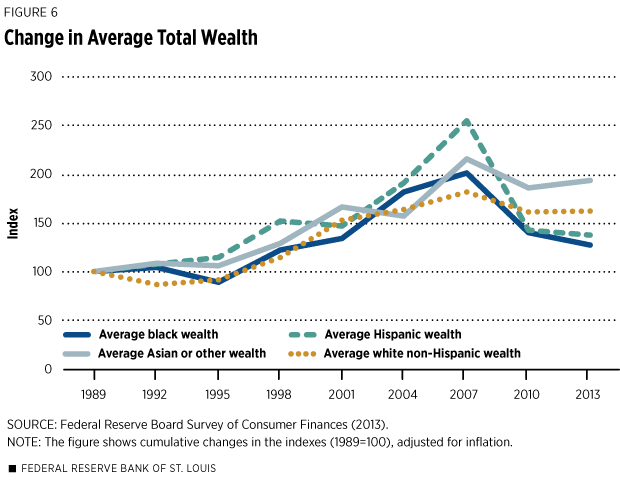St. Louis Fed Analysis Examines Homeowner Equity and the Racial Wealth Divide over Time
ST. LOUIS – The housing market collapse affected millions of American families across the country, but it hit black and Latino families especially hard because so much of their wealth was tied up in housing, according to analysis in the latest edition of the St. Louis Fed’s Housing Market Perspectives report.
“Relatively low cumulative increases in long-run wealth for black and Latino families resulted from large declines in asset values after 2007, when the financial crisis and then the Great Recession took their toll,” said author William R. Emmons, lead economist of the St. Louis Fed’s Center for Household Financial Stability. “In contrast, from 1989 to 2004, black and Latino families experienced greater average overall wealth gains than white and Asian families.
Homeowners’ equity (HOE)—the market value of residential real estate minus the value of home-secured debt—has long been the single largest component of wealth for black and Latino families.
Over the past quarter century, average HOE accounted for close to 50 percent of black and Latino families’ wealth, compared with roughly 32 percent of wealth of Asian or other families, and about 27 percent for white families. Indeed, during peaks reached in 1989 and 2007, HOE represented even more than 50 percent of the wealth of the average black and Latino family.
Over the long term however, HOE contributed less than other assets to wealth accumulation during the 1989-2013 period, according to the Federal Reserve’s latest Survey of Consumer Finances
For black and Hispanic families, “After 2007, large price declines and the loss of many homes through foreclosure or other distressed transactions served to reduce the 2013 share of wealth attributed to HOE,” Emmons explained.
“The drag exerted by poorly performing housing assets on total wealth accumulation is starkly illuminated when comparing the major racial and ethnic groups,” Emmons said. “Wealth gains for blacks and Latinos suffered between 1989 and 2013 because most of their wealth was concentrated in homeowners’ equity.”
During this time period, as shown in the table below, the inflation-adjusted value of HOE increased by only 0.5 percent per year for Hispanic families and actually declined, on average, by 0.4 percent per year for black families. White and Asian families, by contrast, saw significant increases, due to having much larger investments in non-housing assets.
Average Annual Percent Change in Inflation-adjusted Asset Values, 1989-2013
| Homeowners’ equity (HOE) | All other assets less liabilities, excluding HOE | Total wealth (all assets less all liabilities) | |
|---|---|---|---|
| Black | -0.4% | 2.3% | 1.0% |
| Hispanic | 0.5% | 2.1% | 1.3% |
| Asian or other | 2.5% | 2.9% | 2.8% |
| White non-Hispanic | 1.2% | 2.3% | 2.0% |
| All families | 1.0% | 2.1% | 1.8% |
SOURCE: Federal Reserve Board Survey of Consumer Finances (2013).
The chart below makes clear that the relatively low cumulative increases in long-run wealth for black and Latino families resulted from large declines in asset values after 2007, when the financial crisis and then the Great Recession took their toll, Emmons said. “The devastating collapse of housing markets after 2007 hit black and Latino families particularly hard because so much of their wealth was tied up in housing.”

-
Anthony Kiekow
314-949-9739
-
Shera Dalin
314-591-3457
-
Tim Lloyd
314-202-1381

